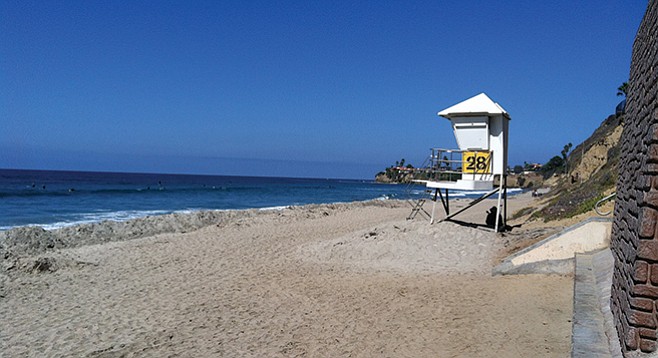 Facebook
Facebook
 X
X
 Instagram
Instagram
 TikTok
TikTok
 Youtube
Youtube

At Tourmaline in Pacific Beach there is a trench about 100 yards offshore that runs parallel to the beach. This trench has a major effect on how a wave approaches the shore. Based on a wave’s height, it is water depth that determines where the wave will begin to break. When a wave approaches the beach at Tourmaline from the outside, it looks big and ready to break. A surfer will turn and start paddling to catch the wave and have it roll underneath him, passing him by.
“A bigger board helps at Tourmaline,” says Chad. “The bigger the board, the better the chance to catch a Tourmaline wave. It’s a great wave if you don’t mind having five other people going straight down the wave with you.”
Beginners always go straight down the wave instead of going left or right. It blocks other surfers from getting a long ride.
Mike T., a daily surfer at Tourmaline, explains that one of the best things about the Tourmaline wave is that when it does break, it breaks in many spots. Great surf spots like Windansea have only one peak and only one or two surfers can be on the wave at the same time (unless someone drops in on you). At Tourmaline there can be several surfers on the same wave, assuming the beginners learn to go left or right and not straight down the wave.
Ryan Broley, 38, is a former surfer from Tourmaline and now surfs in Del Mar. “At Del Mar on 16th Street we have a similar wave we call the Del Mar Bump. You catch the wave on the outside, then you have to bump the wave (make an up and down motion on the board, which gives it some forward momentum) until you get to the inside, and the wave picks up again.”


At Tourmaline in Pacific Beach there is a trench about 100 yards offshore that runs parallel to the beach. This trench has a major effect on how a wave approaches the shore. Based on a wave’s height, it is water depth that determines where the wave will begin to break. When a wave approaches the beach at Tourmaline from the outside, it looks big and ready to break. A surfer will turn and start paddling to catch the wave and have it roll underneath him, passing him by.
“A bigger board helps at Tourmaline,” says Chad. “The bigger the board, the better the chance to catch a Tourmaline wave. It’s a great wave if you don’t mind having five other people going straight down the wave with you.”
Beginners always go straight down the wave instead of going left or right. It blocks other surfers from getting a long ride.
Mike T., a daily surfer at Tourmaline, explains that one of the best things about the Tourmaline wave is that when it does break, it breaks in many spots. Great surf spots like Windansea have only one peak and only one or two surfers can be on the wave at the same time (unless someone drops in on you). At Tourmaline there can be several surfers on the same wave, assuming the beginners learn to go left or right and not straight down the wave.
Ryan Broley, 38, is a former surfer from Tourmaline and now surfs in Del Mar. “At Del Mar on 16th Street we have a similar wave we call the Del Mar Bump. You catch the wave on the outside, then you have to bump the wave (make an up and down motion on the board, which gives it some forward momentum) until you get to the inside, and the wave picks up again.”
Comments